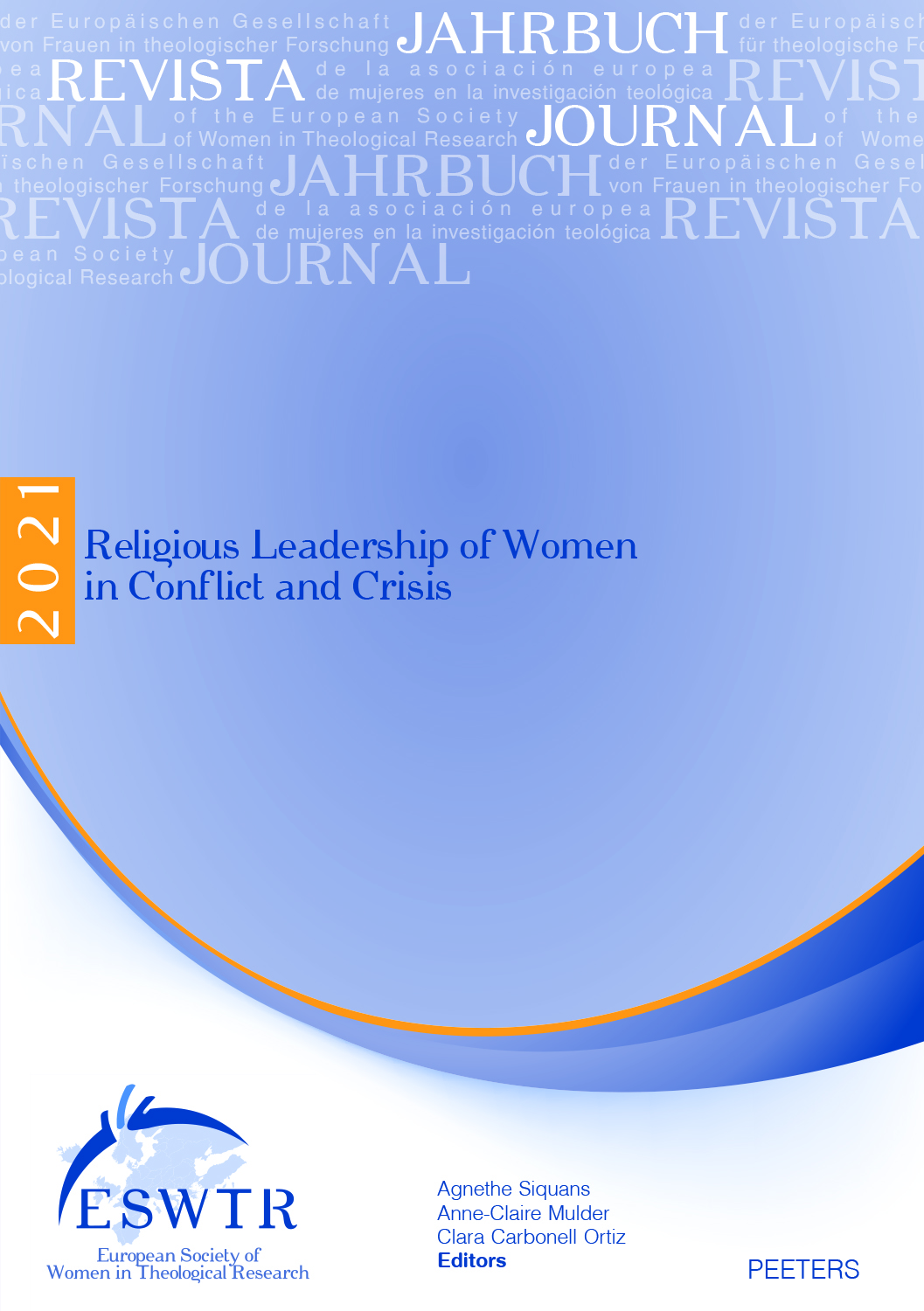 previous article in this issue previous article in this issue | next article in this issue  |

Preview first page |
Document Details : Title: Bones Talking Back Subtitle: Theology and Public Mourning after the Crash of Flight MH17 Author(s): VAN DEN BERG, Mariecke Journal: Journal of the European Society of Women in Theological Research Volume: 27 Date: 2019 Pages: 175-195 DOI: 10.2143/ESWTR.27.0.3286561 Abstract : In this article I formulate a theological response to the shocking event of the crash of Malaysia Airlines flight 17 (MH17), which was shot down over Eastern Ukraine on 17 July 2014. None of the 298 passengers survived the crash. Moreover, since the plane crashed in territory where separatist militias were involved in an armed conflict with the Ukrainian military, the victims’ bodies could not be removed from the crash site for several days. I address how displays of public grief, such as those in the aftermath of MH17, are embedded in a ‘politics of mourning’ in which feelings of loss and despair are expressed against the backdrop of particular political entanglements and national histories. In the case of MH17, these entanglements included a construction of the civilized Western mourner versus the barbaric Ukrainian separatist who does not know how to properly treat a body. Taking the body as my point of departure and using Mario Aguilar’s notion of a ‘hermeneutics of bones’, I trace some of the ‘past narratives of God and bones’ in the Old Testament. These narratives show that Old Testament accounts of bones testify to the deep notion of human beings as created by God and are therefore a place to locate God in times of despair (e.g. in Job). Moreover, Old Testament renderings of bones can offer the comfort of language and speakability. They show how bones can be a site of ultimate humiliation, but also the site where dignity is restored. I then turn to a more in-depth reading of Rizpah, who in 2 Samuel 21 publicly mourns over the bones of her sons for six months until they receive a proper burial at the hands of King David, thereby changing the power constellations that had led to their deaths in the first place. In diesem Artikel formuliere ich eine theologische Antwort auf das schockierende Ereignis des Absturzes des Fluges 17 (MH17) von Malaysia Airlines, der am 17. Juli 2014 über der Ostukraine abgeschossen wurde. Keiner der 298 Passagiere überlebte den Unfall. Da das Flugzeug in einem Gebiet abstürzte, in dem separatistische Milizen in einen bewaffneten Konflikt mit dem ukrainischen Militär verwickelt waren, konnten die Körper der Opfer mehrere Tage lang nicht von der Absturzstelle entfernt werden. Ich spreche darüber, wie Darstellungen öffentlicher Trauer, wie sie beispielsweise nach MH17 entstanden sind, in eine 'Politik der Trauer' eingebettet sind, in der Gefühle von Verlust und Verzweiflung vor dem Hintergrund bestimmter politischer Verflechtungen und nationaler Geschichten zum Ausdruck kommen. Im Falle von MH17 beinhalteten diese Verwicklungen eine Konstruktion des zivilisierten westlichen Trauernden gegen den barbarischen ukrainischen Separatisten, der nicht weiß, wie man einen Körper richtig behandelt. Ausgehend vom Körper als Ausgangspunkt und unter Verwendung von Mario Aguilars Vorstellung einer 'Hermeneutik der Knochen' verfolge ich einige der 'vergangenen Erzählungen von Gott und den Knochen' im Alten Testament. Diese Erzählungen zeigen, dass alttestamentliche Knochenberichte von der tiefen Vorstellung des Menschen, wie er von Gott geschaffen wurde, zeugen und daher ein Ort sind, um Gott in Zeiten der Verzweiflung (z.B. in Hiob) zu finden. Darüber hinaus können alttestamentliche Darstellungen von Knochen den Komfort von Sprache und Sprechfertigkeit bieten. Sie zeigen, wie Knochen ein Ort der ultimativen Erniedrigung sein können, aber auch der Ort, an dem die Würde wiederhergestellt wird. Ich wende mich dann einer vertieften Lektüre von Rizpa zu, die im Jahr 2 Samuel 21 sechs Monate lang öffentlich über die Knochen ihrer Söhne trauert, bis sie durch König David ein ordentliches Begräbnis erhalten und damit die Machtkonstellationen verändern, die überhaupt zu ihrem Tod geführt haben. En este artículo, formulo una repuesta teológica al traumático evento del accidente aéreo del vuelo 17 de Malaysia Airlines (MH17), que fue derribado en Ucrania oriental el 17 de julio de 2014. Ninguno de los 298 pasajeros sobrevivió al accidente. Además, desde que el avión se estrellara en el territorio en el que las milicias separatistas se encontraban sumidas en un conflicto armado con el ejército ucraniano, los cuerpos de las víctimas no pudieron retirarse del lugar del accidente durante varios días. Abordo cómo las demostraciones públicas de luto, como aquellas tras el MH17, están engarzadas en una 'política del lamento' donde los sentimientos de pérdida y desesperación se expresan contra el trasfondo de ciertos entresijos políticos e historias nacionales. En el caso del MH17, estos entresijos incluían la construcción de un doliente occidental civilizado versus el separatista ucraniano bárbaro que no sabe cómo tratar correctamente a un cuerpo. Tomando al cuerpo como mi punto de partida y usando la noción de la 'hermenéutica de los huesos' de Mario Aguilar, trazo algunas de las 'narrativas pasadas de Dios y los huesos' en el Antiguo Testamento. Estas narrativas muestran cómo el Antiguo Testamento da cuenta de huesos que testifican sobre la profunda noción de los seres humanos como creados por Dios y son, por lo tanto, un lugar donde ubicar a Dios en tiempo de desesperación (por ejemplo, en Job). Además, las representaciones de huesos del Antiguo Testamento pueden ofrecer el consuelo del lenguaje y del no tabú. Muestran cómo los huesos pueden ser un lugar de humillación última, pero también el lugar en el que se restaura la dignidad. Regreso, entonces, a una lectura en mayor profundidad de Rizpah, quien, en 2 Samuel 21, llora públicamente a los huesos de sus hijos durante seis meses hasta que reciben una sepultura digna a manos del rey David, cambiando así las constelaciones de poder que les habían dirigido hacia la muerte en un primer momento. |
 |


